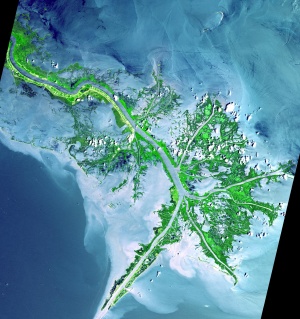Abstract AAPG 2010
Human and Natural Controls on a Delta’s Surface Elevation Relative to Local Mean Sea Level
James P.M. Syvitski, Albert J. Kettner, Irina Overeem, Eric W.H. Hutton, Mark T. Hannon
CSDMS Integration Facility, INSTAAR, University of Colorado, Boulder CO, 80309-0545
Abstract
Vertical change in a delta’s surface relative to local mean sea level, DRSL, is determined by five factors:
DRSL = A - DE - Cn - CA ± M.
A delta’s Aggradation Rate (A) is determined from the volume of sediment delivered to and retained on the subaerial delta surface as new sedimentary layers, and typically varies from 1 to 50 mm/y. Dam interception of upstream river-borne sediment presently leaves modern rivers with relatively clean water, reduced flood magnitude, discharged within fewer distributary channels armored with artificial levees. Flooding from ocean surges can sometimes contribute turbid water. DE, the Eustatic Sea Level Rate, is influenced by fluctuations in the storage of terrestrial water (e.g. glaciers, ice sheets, groundwater, lakes, and reservoirs), and fluctuations in ocean water expansion due to temperature. Today DE contributes 1.8 to 3 mm/y under the influence of global warming. Deltaic shorelines are experiencing extraordinary rates of relative sea level rise due to non-eustatic forcing. Natural Compaction (Cn), or Accelerated Compaction (CA) reduce the volume of deltaic deposits respectively through:
- dewatering, grain-packing realignment, and organic matter oxidation (typically ≤3 mm/y); and
- subsurface mining (oil, gas or groundwater), human-influenced soil drainage and accelerated oxidation.
CA can exceed Cn by an order of magnitude. M is the typically downward vertical movement of the land surface as influenced by the redistribution of earth masses (e.g. sea level fluctuations, growth of delta deposits, growth or shrinkage of nearby ice masses, tectonics, and deep-seated thermal subsidence). M is highly variable spatially but rates are typically between 0 and -5 mm/y. A majority of the modern deltas are now sinking at rates many times faster than global sea level is rising. Categories identified include those where:
- Reduced aggradation that can no longer keep up with local sea level rise (Brahmani, Godavari, Indus, Mahanadi, Parana, and Vistula);
- Reduction in aggradation plus accelerated compaction are overwhelming global sea level rise rates (Ganges, Irrawaddy, Magdalena, Mekong, Mississippi, Niger, Nile, and Tigris); and
- Delta aggradation has ceased and/or anthropogenic compaction is very high (Chao Phraya, Colorado, Krishna, Nile, Pearl, Po, Rhone, Sao Francisco, Tone, Yangtze and the Yellow).

